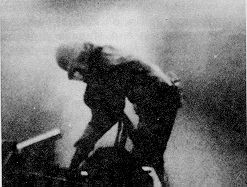Silicosis
- Silica Dust Exposure & Prevention
 Crystalline
silica may be of several distinct types.Quartz, a form of silica
and the most common mineral on earth, is contained in many types
of rocks and is the major component of sand. Concrete
and masonry products contain silica and rock and rock containing
silica.Therefore it is easy to recognize how industrial workers
may be exposed to free crystalline silica while in the following
work activities: Crystalline
silica may be of several distinct types.Quartz, a form of silica
and the most common mineral on earth, is contained in many types
of rocks and is the major component of sand. Concrete
and masonry products contain silica and rock and rock containing
silica.Therefore it is easy to recognize how industrial workers
may be exposed to free crystalline silica while in the following
work activities:
1)
Sandblasting operations in which sandblasters use silica
sand for blasting
2)
Crushing, loading, hauling, and dumping of rock containing
high percentage of quartz
3)
Abrasive blasting using silica sand as the abrasive
4)
Abrasive blasting of concrete (regardless of abrasive used)
5)
Sawing, hammering, drilling, grinding, and chipping of concrete
or masonry
6)
Demolition of concrete and masonry structures
7)
Dry sweeping or pressurized air blowing of concrete, rock,
or sand dust
8) Chipping, hammering,
and drilling of rock
Other
workers may be exposed to crystalline silica in the following occupations:
-
Sandblasting
of Buildings
-
Sandblasting
of oil field equipment
-
Shipbuilders
-
Surface
Miners
-
Underground
Miners Tunnel workers
-
Ceramic,
Clay, Pottery Workers
-
Glass
Manufacturing
-
Railroad
Workers - (setting & laying track, engine rebuilding)
-
Foundry
Workers - (grinding, molding, shakeout & core room)
-
Manufacturers
of Abrasives
-
Grinders,
Polishers
-
Tombstone
Sandblasters
-
Boiler
Scalers
-
Maritime/Offshore
Rust Removal/Sandblasters
-
Welders
-
Soap
and Detergent Workers
-
Nuclear Testing Sites
How
Does Silica Become Free Silica ?
When Silica (SiO2) combines with
other cations to form Silicates, then the SiO2 is no longer "free".
Free Silica exists in three forms, amorphous, cryptocrystalline
and polymorphic crystalline.
Mining or quarrying of any rock
that contains siliceous material may produce hazardous exposures
to "free" Silica. Thus, the mining of copper, gold, platinum,
tin, uranium or even coal may produce high exposures. Tunneling
in rock containing high concentrations of quartz may produce severe
exposures. The quarrying, rock drilling, chipping and cutting of
granite,sandstone and slate may produce high exposures of silica from
the quarry face where modern flame cutters may have increased exposure
through all aspects of cutting, dressing, and polishing the quarried
stone. Abrasive blasting and other uses such as scouring and polishing
where Silica flows may be used may cause rapidly progressive disease.
Other significant exposures may occur in glass manufacture, production
of pottery, porcelain and lining bricks, boiler scaling, and enameling.
The production and use of refractory
brick (firebrick) containing silica may pose significant health
hazards particularly after they have been exposed to high temperatures
as a significant major proportion of the Silica is transformed to
cristobalite or tridymite. Bricklayers and others who maintain and
dismantle the refractory brick of ovens, furnaces and other similar
devices are exposed to a serious silica hazard.
Foundry work is still
a major source of "free" Silica exposure. In all stages
of the foundry process from core making through "shake-out"
to maintenance and repair, "free" Silica exposures occur
along with other potentially hazardous exposures to metal fumes,
asbestos and toxic gases. As the quartz-containing sand used in
the molds is exposed to hot metal, formation of cristobalite may
occur. It is not uncommon for such sand to be used on a repeated
basis leading to further increases in the concentration of cristobalite.

|




